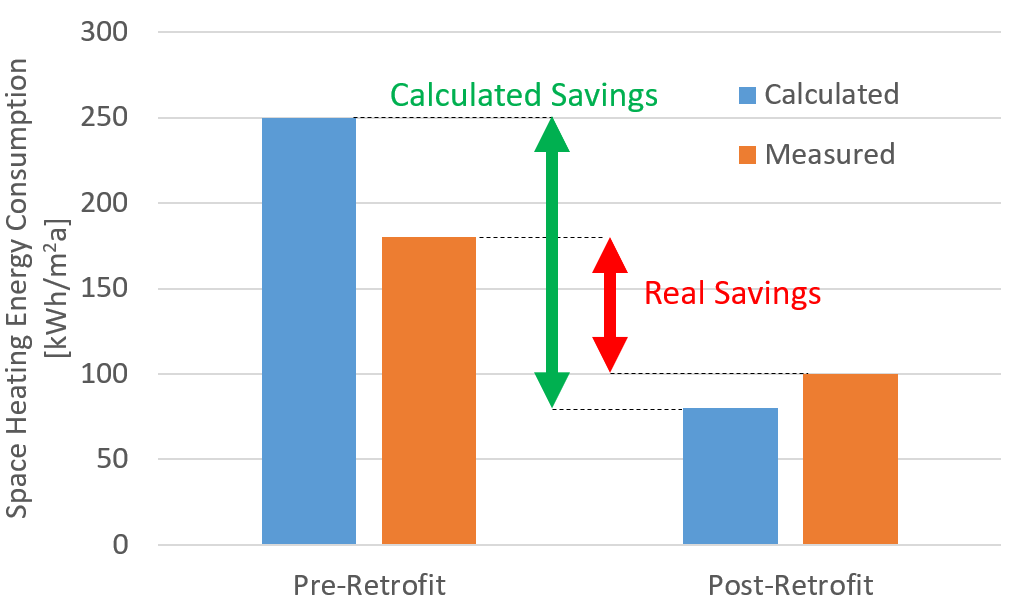
Why old buildings matter – The story of building refurbishments
On 10.06.2021 by Mario FreiMario Frei is a doctoral researcher at the Chair of Architecture and Building Systems. He is conducting research on measurement-data-based building refurbishments, investigating how to use wireless sensors for more efficient building refurbishments.
It is estimated that buildings are responsible for 36% of global final energy use and 40% of the energy-related greenhouse gas emissions in Europe. Buildings are also complex machines with long life cycles, which include regular maintenance and updates. Thus, buildings and particularly building refurbishments provide manifold and exciting opportunities to address climate change issues at low cost and with (free) co-benefits.
Buildings consume 30 to 40% of global final energy use, making them a major source of CO2 emissions. The International Energy Agency has identified energy efficiency in buildings as one of the five measures to secure long-term decarbonization of the energy sector. While this can only be achieved by wide-scale retrofitting of existing buildings, the current rate of refurbishing buildings is very low at around 1% due to numerous technological, analytical, behavioral, and economic factors. Some of these factors emerge as a performance gap, where the calculated energy demand of a building is significantly different from the measured energy demand. We propose to bridge this gap by using measured data from individual buildings to improve the effectiveness of building refurbishments. We believe that sensor-driven building refurbishments will accelerate the refurbishment rate and contribute to a future with green and sustainable built environments.
Why are building refurbishments important?
The environmental footprint of buildings is enormous. Their use is diverse and ranges from simple barns for storage to mixed-use high-rise buildings. Contrary to most common commodities, buildings in Europe tend to have a long lifespan of 60-100 years. In Switzerland, most of the buildings were built before 1990. Consequently, most of the buildings existing in 2050 are already built today. However, there are many building elements and systems that have shorter lifespans than the entire building. Hence, replacements of building elements in refurbishments are common.
Often, there are many stakeholders involved with diverse concerns, e.g., planners, builders, owners, tenants, occupants, caretakers, financial institutions, and authorities. Notably, the construction and maintenance of a building are inherently multidisciplinary, which requires experts from various disciplines such as architecture and various engineering, e.g., heating, ventilation, sanitary, electricity, communication, fire protection, and structural. The multidisciplinarity is also reflected in the supply chains to buildings, e.g., communication, water, electricity, steam, oil, gas, district heat, and wood.
Why are building refurbishments going so slow?
The current building refurbishment rate in Switzerland sits at 1% and must increase to reach the goals of the energy strategy 2050 outlined by the federal government. A building refurbishment rate of at least 2.2% is necessary to achieve the goals of the energy strategy 2050. Among the reasons for the low building refurbishment rate are financial constraints, lack of knowledge, overwhelming complexity, and fear of undesirable repercussions, such as moisture damages or mold growth. But building refurbishments also offer co-benefits aside from the improved thermal performance. Such co-benefits include conservation of value, increased thermal comfort, increased health, better indoor air quality, outdoor noise protection, and lower operation and maintenance costs. Finding the optimal set of refurbishment measures is not trivial due to the aforementioned complexity and the fact that the energy savings of a set of refurbishment measures are not equal to the energy savings from refurbishment measures applied separately. Knowing what measures to prioritize for each specific building can help make more cost-effective building refurbishments possible, which can help to increase the refurbishment rate and, ultimately, the speed of the greenhouse gas emission reduction.
In our work, we want to improve the refurbishment process and potentially decrease the costs by addressing the performance gap with sensor-based input data and grey-box modelling.
The Performance Gap & Ineffective Refurbishments
One reason for ineffective building refurbishments is the performance gap, i.e., the measured energy savings are lower than expected. This phenomenon can be split into two effects; the prebound effect and the rebound effect (see Figure).
Currently, building assessors estimate current building characteristics based on visual inspections and personal experience, which introduces significant uncertainties about the pre-refurbishment state of the building into the assessment. For example, the thermal properties of walls need to be guessed due to a lack of documentation. To account for these uncertainties, safety margins (e.g., oversizing the heat pump, adding more insulation) need to be considered when proposing refurbishment measures, which increases the cost of building refurbishments, decreases the performance of building refurbishments, and makes combinations of refurbishment interventions appear unfeasible. Therefore, safety margins reduce the probability of ideal refurbishment interventions being implemented, e.g., the new heating system is made larger than actually needed. These issues generally cause an overestimation of the current energy demand of a building, which is called the pre-bound effect. During the execution of a refurbishment, the quality of workmanship and construction materials introduce additional variation to the energy performance of the refurbished building. Finally, after the refurbishment, occupant behavior can change and influence energy demand. These uncertainties are called the rebound effect. In the worst case, energy savings from a refurbishment are curtailed twice, once before the refurbishment due to an overestimation of the current energy demand and once after the refurbishment due to an under-estimation of the post-refurbishment energy demand. Combined, these effects amount to a performance gap of 30% on average. This indicates that applied refurbishment measures underperform significantly. Hence, the investments into these refurbishment measures are not effective.
Building assessment of the future
The lack of objectivity in building energy assessments (pre-bound effect) can be addressed by measuring thermal building properties with sensors inside the buildings. Quality control after the implementation of the refurbishments can be done with sensors as well (rebound effect). This has become more feasible due to the rapid development in electronics and battery technology. While initial research can be done in test chambers and testbed buildings, ultimately, the new approaches need to be deployed in real-life occupied buildings. In our research, we addressed the practical challenges with a versatile wireless sensor network (see header image). In other words, we try to make the blue and orange columns in the figure above the same sizes. With sensor deployment in real-life buildings, we discovered some practical challenges. For example, measuring the heating input into a building is surprisingly challenging when done at scale and at reasonable costs. This is due to the many energy carriers available, e.g., oil, gas, electricity, wood, district heat, etc., and diverse energy system setups, where the energy carrier for the heating might be used for other purposes such as domestic hot water. In addition, research needs to widen the focus from building energy assessment and also include building refurbishment based on improved building assessment methods.
While the built environment is one of the largest, if not the single largest, energy consumers and greenhouse gas emitters, addressing the issues requires solutions from many domains. The experts from these domains need to work together to combine all solutions to reduce energy demand and emissions while also creating co-benefits at the same time.
Keep up with the Energy Blog @ ETH Zurich on Twitter @eth_energy_blog.
Suggested citation: Frei, Mario “Why old buildings matter – The story of building refurbishments”, Energy Blog @ ETH Zurich, ETH Zurich, June 10, 2021, https://blogt.ethz.ch/energy/old-buildings-matter/
If you are part of ETH Zurich, we invite you to contribute with your findings and your opinions to make this space a dynamic and relevant outlet for energy insights and debates. Find out how you can contribute and contact the editorial team here to pitch an article idea!


